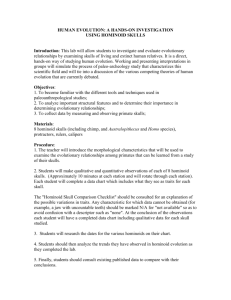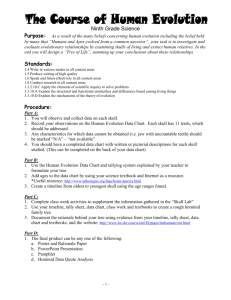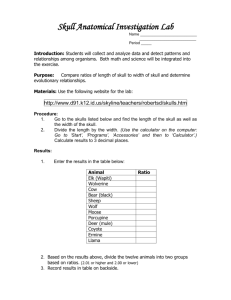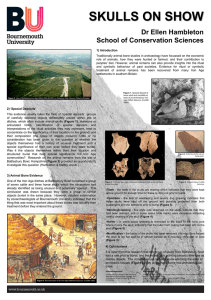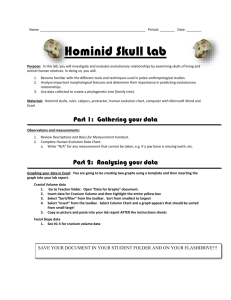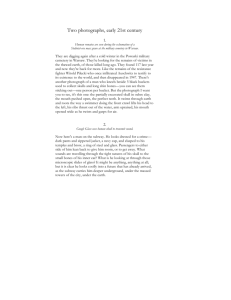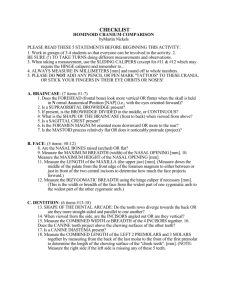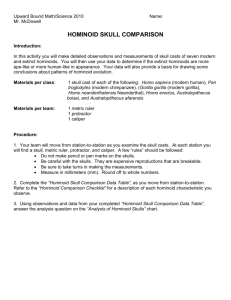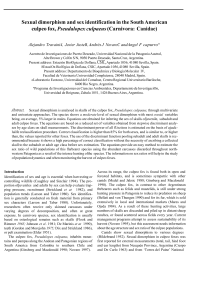Meet the Hominoids
advertisement
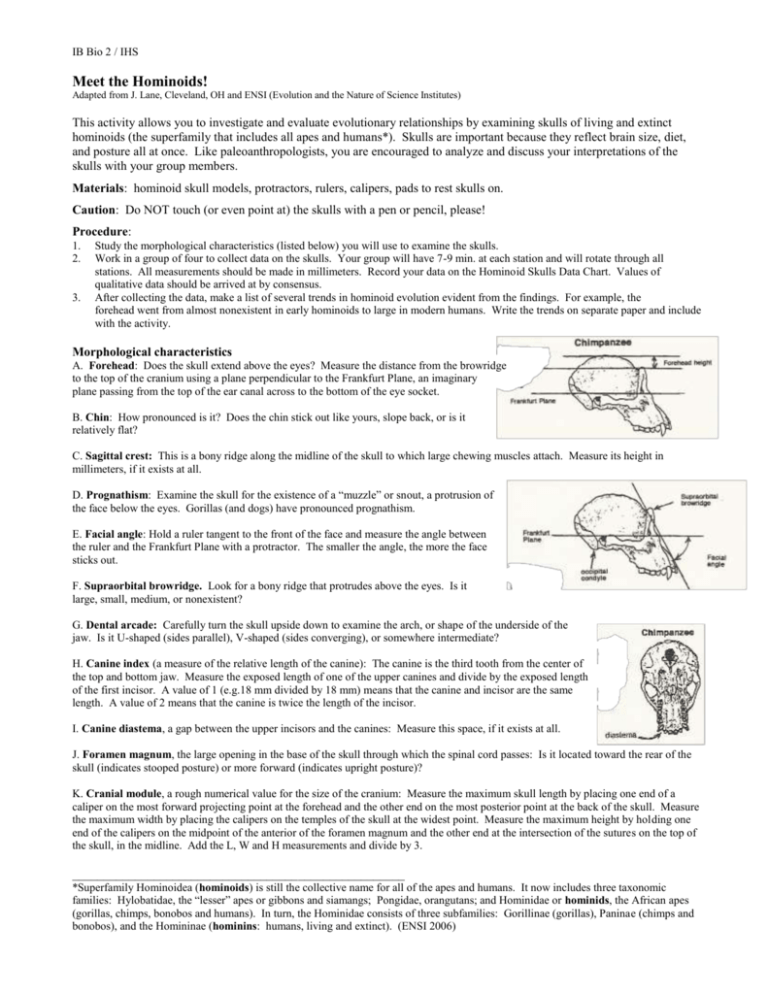
IB Bio 2 / IHS Meet the Hominoids! Adapted from J. Lane, Cleveland, OH and ENSI (Evolution and the Nature of Science Institutes) This activity allows you to investigate and evaluate evolutionary relationships by examining skulls of living and extinct hominoids (the superfamily that includes all apes and humans*). Skulls are important because they reflect brain size, diet, and posture all at once. Like paleoanthropologists, you are encouraged to analyze and discuss your interpretations of the skulls with your group members. Materials: hominoid skull models, protractors, rulers, calipers, pads to rest skulls on. Caution: Do NOT touch (or even point at) the skulls with a pen or pencil, please! Procedure: 1. 2. 3. Study the morphological characteristics (listed below) you will use to examine the skulls. Work in a group of four to collect data on the skulls. Your group will have 7-9 min. at each station and will rotate through all stations. All measurements should be made in millimeters. Record your data on the Hominoid Skulls Data Chart. Values of qualitative data should be arrived at by consensus. After collecting the data, make a list of several trends in hominoid evolution evident from the findings. For example, the forehead went from almost nonexistent in early hominoids to large in modern humans. Write the trends on separate paper and include with the activity. Morphological characteristics A. Forehead: Does the skull extend above the eyes? Measure the distance from the browridge to the top of the cranium using a plane perpendicular to the Frankfurt Plane, an imaginary plane passing from the top of the ear canal across to the bottom of the eye socket. B. Chin: How pronounced is it? Does the chin stick out like yours, slope back, or is it relatively flat? C. Sagittal crest: This is a bony ridge along the midline of the skull to which large chewing muscles attach. Measure its height in millimeters, if it exists at all. D. Prognathism: Examine the skull for the existence of a “muzzle” or snout, a protrusion of the face below the eyes. Gorillas (and dogs) have pronounced prognathism. E. Facial angle: Hold a ruler tangent to the front of the face and measure the angle between the ruler and the Frankfurt Plane with a protractor. The smaller the angle, the more the face sticks out. F. Supraorbital browridge. Look for a bony ridge that protrudes above the eyes. Is it large, small, medium, or nonexistent? G. Dental arcade: Carefully turn the skull upside down to examine the arch, or shape of the underside of the jaw. Is it U-shaped (sides parallel), V-shaped (sides converging), or somewhere intermediate? H. Canine index (a measure of the relative length of the canine): The canine is the third tooth from the center of the top and bottom jaw. Measure the exposed length of one of the upper canines and divide by the exposed length of the first incisor. A value of 1 (e.g.18 mm divided by 18 mm) means that the canine and incisor are the same length. A value of 2 means that the canine is twice the length of the incisor. I. Canine diastema, a gap between the upper incisors and the canines: Measure this space, if it exists at all. J. Foramen magnum, the large opening in the base of the skull through which the spinal cord passes: Is it located toward the rear of the skull (indicates stooped posture) or more forward (indicates upright posture)? K. Cranial module, a rough numerical value for the size of the cranium: Measure the maximum skull length by placing one end of a caliper on the most forward projecting point at the forehead and the other end on the most posterior point at the back of the skull. Measure the maximum width by placing the calipers on the temples of the skull at the widest point. Measure the maximum height by holding one end of the calipers on the midpoint of the anterior of the foramen magnum and the other end at the intersection of the sutures on the top of the skull, in the midline. Add the L, W and H measurements and divide by 3. _____________________________________________________ *Superfamily Hominoidea (hominoids) is still the collective name for all of the apes and humans. It now includes three taxonomic families: Hylobatidae, the “lesser” apes or gibbons and siamangs; Pongidae, orangutans; and Hominidae or hominids, the African apes (gorillas, chimps, bonobos and humans). In turn, the Hominidae consists of three subfamilies: Gorillinae (gorillas), Paninae (chimps and bonobos), and the Homininae (hominins: humans, living and extinct). (ENSI 2006)
